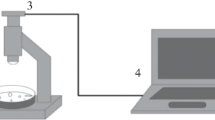Abstract
Observation of films of biological liquids allows finding markers of diseases such as diabetes or pneumonia. This may allow switching to more cost-effective diagnostic methods based on the use of relatively cheap commodity hardware required for optical microscopy. For this propose cuneiform dehydration of biological fluids is a promising method of medical diagnosis based on the study of structures in blood serum films. Currently, these structures are investigated at a qualitative level. It is known, that the geometric parameters of structures in blood serum films may be caused by some pathologies. In this paper the problems of image segmentation considered to create an image processing algorithm. Additionally, the images processing algorithm of blood serum films is described and experimental results are presented.




Similar content being viewed by others
REFERENCES
Shariaty, F., Baranov, M., Velichko, E., Galeeva, M., and Pavlov, V., Radiomics: Extracting more Features using Endoscopic Imaging, in IEEE International Conference on Electrical Engineering and Photonics (EExPolytech), IEEE, 2019, pp. 181–194.
Shariaty, F., Davydov, V., Yushkova, V., Glinushkin, A., and Rud, V.Y., Automated pulmonary nodule detection system in computed tomography images based on Active-contour and SVM classification algorithm, J. Phys.: Conf. Ser., 2019, vol. 1410, no. 1, p. 012075.
Wang, T., Lei, Y., Shafai-Erfani, G., Jiang, X., Dong, X., Zhou, J., and Yang, X., Learning-based automatic segmentation on arteriovenous malformations from contract-enhanced CT images, in Medical Imaging 2019, Computer-Aided Diagnosis, 2019, vol. 10950, p. 109504D.
Kraevoy, S. and Koltovoy, N., Diagnosis Using a Single Drop of Blood. Biofluid Crystallization, Moscow–Smolensk, 2016.
Baranov, M.A., Velichko, E.N., and Andryakov, A.A., Image processing for analysis of bio-liquid films, Opt. Mem. Neural Networks, 2020, vol. 29, no. 1, pp. 1–6.
Krasheninnikov, V.R., Malenova, O.E., and Yashina, A.S., Markers detection on facies of human biological fluids, Procedia Eng., 2017, vol. 201, pp. 312–321.
Shabalin, V. and Shatokhina, S., Diagnostic markers in the structures of human biological liquids, Singapore Med. J., 2007, vol. 48, no. 5, p. 440.
Gulka, C.P. et al., Coffee rings as low-resource diagnostics: detection of the malaria biomarker plasmodium falciparum histidine-rich protein-ii using a surface-coupled ring of ni (ii) nta gold-plated polystyrene particles, ACS Appl. Mater. Interfaces, 2014, vol. 6, no. 9, pp. 6257–6263.
Vardhana, M., Arunkumar, N., Lasrado, S., Abdulhay, E., and Ramirez-Gonzalez, G., Convolutional neural network for bio-medical image segmentation with hardware acceleration, Cognit. Syst. Res., 2018, vol. 50, pp. 10–14.
Shariaty, F. and Mousavi, M., Application of CAD systems for the automatic detection of lung nodules, Inf. Med. Unlocked, 2019, vol. 15, p. 100173.
Senthilnath, J., Kulkarni, S., Benediktsson, J.A., and Yang, X.-S., A novel approach for multispectral satellite image classification based on the bat algorithm, IEEE Geosci. Remote Sens. Lett., 2016, vol. 13, no. 4, pp. 599–603.
Billah, M. and Waheed, S., Gastrointestinal polyp detection in endoscopic images using an improved feature extraction method, Biomed. Eng. Lett., 2018, vol. 8, no. 1, pp. 69–75.
Zacharaki, E.I. et al., Classification of brain tumor type and grade using MRI texture and shape in a machine learning scheme, Magnetic Resonance in Medicine: An Official J. Int. Soc. Magn. Reson. Med., 2009, vol. 62, no. 6, pp. 1609–1618.
Affonso, C., Rossi, A.L.D., Vieira, F.H.A., and de Leon Ferreira, A.C.P., Deep learning for biological image classification, Expert Syst. Appl., 2017, vol. 85, pp. 114–122.
Liu, H., Shao, M., Li, S., and Fu, Y., Infinite ensemble for image clustering, in Proceedings of the 22nd ACM SIGKDD International Conference on Knowledge Discovery and Data Mining, 2016, pp. 1745–1754.
Manning, C.D., Raghavan, P., and Schütze, H., Introduction to Information Retrieval, Cambridge Univ. Press, 2008.
Yang, J., Parikh, D., and Batra, D., Joint unsupervised learning of deep representations and image clusters, in Proceedings of the IEEE Conference on Computer Vision and Pattern Recognition, 2016, pp. 5147–5156.
Shariaty, F., Hosseinlou, S., and Rud, V.Y., Automatic lung segmentation method in computed tomography scans, J. Phys.: Conf. Ser., 2019, vol. 1236, no. 1, p. 012028.
Kugelman, J., Alonso-Caneiro, D., Read, S.A., Hamwood, J., Vincent, S.J., Chen, F.K., and Collins, M.J., Automatic choroidal segmentation in OCT images using supervised deep learning methods, Sci. Rep., 2019, vol. 9, no. 1, pp. 1–13.
Wang, G. et al., Interactive medical image segmentation using deep learning with image-specific fine tuning, IEEE Trans. Med. Imaging, 2018, vol. 37, no. 7, pp. 1562–1573.
Carreón, Y.J., Ríos-Ramírez, M., Moctezuma, R., and González-Gutiérrez, J., Texture analysis of protein deposits produced by droplet evaporation, Sci. Rep., 2018, vol. 8, no. 1, pp. 1–12.
ACKNOWLEDGMENTS
Authors would like to express their gratitude to Tristan MALLEVILLE and the professor Samy Blusseau’s for valuable comments and discussions of this work.
Funding
This research work was supported by Peter the Great St. Petersburg Polytechnic University in the framework of the Program “5-100-2020”.
Author information
Authors and Affiliations
Corresponding author
Ethics declarations
The authors declare that they have no conflicts of interest.
About this article
Cite this article
Baranov, M., Velichko, E. & Shariaty, F. Determination of Geometrical Parameters in Blood Serum Films Using an Image Segmentation Algorithm. Opt. Mem. Neural Networks 29, 330–335 (2020). https://doi.org/10.3103/S1060992X20040037
Received:
Revised:
Accepted:
Published:
Issue Date:
DOI: https://doi.org/10.3103/S1060992X20040037




